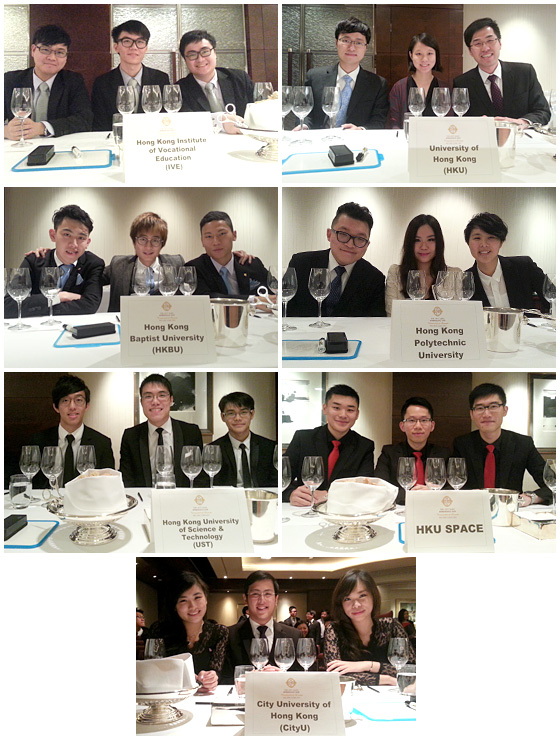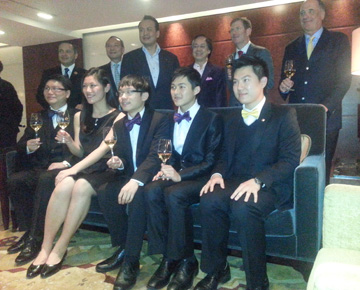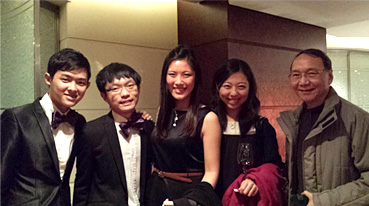The weather was uncharacteristically chilly and damp for Hong Kong on this 8th day of March 2014, but this did not seem to dampen any bit the enthusiasm of those present inside the Lounge Room at the Grand Hyatt Hong Kong Hotel. Actually, once in the room, one could feel the heat from a mixture of anxiety, anticipation and eagerness generated by the competition about to unfurl.
Seated at tables covered with glittering-white table cloth were teams of the 'future elite' from eight of Hong Kong's institutes of higher education: Hong Kong University, The Chinese University of Hong Kong, Hong Kong University of Science and Technology, City University of Hong Kong, Hong Kong Baptist University, Hong Kong Polytechnic University, HKU SPACE and Hong Kong Institute of Vocational Education. These eight teams, each comprised of three members, were competing at the Commanderie du Bontemps Left Bank Bordeaux Cup 2014 and one of them would be chosen to compete against one other team from Asia and two teams each from the USA, France and rest of Europe in the cup final to be held on 25th June 2014 at Château Lafite-Rothschild.
 |
The competition was created in 2002 by the Commanderie du Bontemps de Médoc, des Graves, de Sauternes et de Barsac, one of the oldest French wine appreciation guilds which represents chateaux along the left bank of the Gironde River. This competition was initially for French university wine societies only but starting from 2004 onwards, the competition was opened to British teams when Oxford and Cambridge participated. It became a global contest in 2011 when a team from Harvard Business School won the cup followed by a team from the Chinese University of Hong Kong, my alma mater, taking the second place.
As the 2014 competition unfolded in Hong Kong, the teams, facing a jury of estate owners who are members of the Commanderie du Bontemps, personalities from the Hong Kong wine industry, and in front of an audience of representatives from the media and wine enthusiasts, pit their skills against each other during two heats:
A series of 10 multiple choice questions
A wine tasting carried out in three stages
Through the multiple choice questions, their knowledge of Bordeaux history and trivia was put to the test. Questions that could befuddle lifelong devotees of Bordeaux wines thrown to the teams included: what is the name of the second wine of Chateau Mouton Rothschild? (Le Petit Mouton); what do Chateaux Cos d'Estournel, Lagrange and Lynch Bages have in common? (all produce a white wine); an elephant is the symbol of which chateau? (Cos d'Estournel); and when was the Pessac Léognon appellation created? (9 July 1987).
As if those questions were not difficult enough, the teams were then put through three grueling flights of blind tasting, each flight comprising of three wines. In the first flight, the teams were first to identify the appellation the three wines came from, then to identify the oldest one among the three and then out of the three, to pinpoint which wine was not from a classified estate.
For the second flight, the teams were to identify the vintage from which the three wines all came from, and then they were to identify, out of the three wines, which one did not come from the St. Julien AOC and where did that odd wine out came from? (Margaux AOC).
At the third flight, the teams were given three sweet wines to taste blind. They were asked which one of the three was the oldest, then which was the youngest. It was subsequently disclosed that up to this point, two teams were going neck to neck in their marks and the tie-breaker came at the final question when the teams were asked which one of the three wines was from a classified growth.
 |
| |
 |
The winner was the Chinese University of Hong Kong team and my heartfelt congratulations to the three members. From a short interview I had with them shortly before the result was announced, the team apparently started preparing for the competition since last September and met every three weeks to taste three wines blind so as to build up their data base of the different wines from Bordeaux. Winning the entry ticket to the final competition would mean that the Chinese University of Hong Kong will have a second shot at the Cup and I wish them all the best in their most interesting and yet very demanding endeavours ahead in June! |











